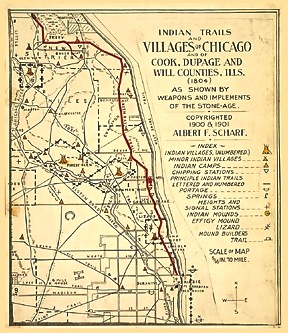
From:
Indian Trails and Villages of Chicago
Albert F. Scharf
1900, 1901
Chicago Historical Society

Next in order we will
outline the works of the ancient builders in the town of Maine, northwest
quarter Sec 34, east of the DesPlaines River and west of Park Ridge, which were
known to Steve Jefferson sixty years ago.
Where trail E. from Forest Glen (six miles) strikes the DesPlaines River
there is a large spring, equal to the pool in Riverside, which undoubtedly
increased the depth of the river, it having here the appearance of a deep canal
with precipitous river banks immediately north of the spring and about half way
between it and the north line of the section, (corresponding to Center Street, in
Park Ridge) the top of the knoll is not more than three hundred feet east of the
river.
This knoll seemingly had been improved into a terrace, to the extent of one
acre by a trench two feet deep which surrounded it on four sides in the shape of
an arrow head minus the point, the butt end lying towards the river and the
setting sun in October. A sacred enclosure similar to those in Ohio, says our
friend Carl Dilg. In the south centre of the enclosure there is an Indian mound,
twenty five feet in diameter and probably eight feet high in its former state.
About one hundred feet to the northwest and also within the enclosure there is a
similar mound of half the size of the former; a little west of which was the
third mound still smaller, but now past locating. Depressions or holes about two
feet deep, to the number of thirty, were found promiscuously along the west
border of the enclosure the most of them between it and the high river bank.
About two hundred feet north of the enclosure, Mr. Lempke the proprieter of
the grounds, found several bushels of "little white stones" (flint chipps) in a
heap, which he buried on the spot. He thought it a great hardship upon himself
and son to scrape and plow to fill up "those holes and ditches" and level of the
mounds in addition to clearing the ground of a heavy growth of timber and in his
estimation the work is still unfinished.
The approximate elevation of the several Indian mounds mentioned here, above
the level of Lake Michigan is respectively at Park Ridge which is the highest --
seventy feet -- those at no. 4. fifty feet -- and Harlem and Riverside about
forty.
In regard to the value of these mounds being what men of knowledge and
science supposed them to be Viz: The work of ancient mound builders of America
-- some investigation was made before 1871, of those at No. 4. and No. 9. and
mentioned in the public print of that time.
A member of the Academy of Science Dr. Edmund Andrews quoting only from
memory says: "That archaelogical specimens from the mound builders at the
DesPlaines River were in the museum of the Academy of Science which was
destroyed by the great Chicago fire in 1871, as were also the records of the
society, but Dr John A. Kennicott or Secretary Stimpson may have left a record in
some of their works."
"These mounds were built by a tribe of Indians which built mounds. In the
Northwest of the present day there are several tribes who built mounds. The
mounds here were not claimed by the Indians and they could not give any account
of them, but the pieces of skull found did not differ from those of our own
Indians."
The mounds at Park Ridge partially examined by different parties with
permission of Mr. Lempke shows the plain Indian inverted with his weapons ready
for the happy hunting ground. The large mound today is discernable from the
wagon road on the south and is still about three feet high. The trench can be
located on the north, also on the southwest corner opposite the road.
Of the mounds at Indian village No. 4, four of them can yet be discerned the
fifth one being mostly cut away in building the public road, when an Indian
skull is said to have been found as related by Mrs. Rusell.
We have shown that these monumental mounds were well located also with
referance to the proximity of the highth of land, to the mouth of Chicago River
and the elevation of Lake Michigan in all ages. Being situated in an ancient
bayou from where a direct route would cross the highest part of the Chicago
plateau.
The Park Ridge Indian village was well located as a way-station on trail E.
& D. running to the Fox Lake country and the Kishwaukee Valley. The trail
passing the spring runs right through the Indian village, crossing the
DesPlaines River in Sec. 28 town of Maine, as did the stage coach in pioneer
days, coming up from Chicago by way of the six mile house (John McLean).
The product of the chipping station here, as well as that at No. 4, was of a
superiour order. The large number of small war points might speak for war
parties from the north as Thornton does from the south. But the remains of
Indian pottery are more plentyful that at any village yet spoken of -- There is
known to be a large supply of blue clay in the vicinity.
The scenery here is grand, there being here also a magnificent slope to the
south where the river is shallow and gravelly and the shore is clean. This
village like no. 10 and no. 14 is within the ten mile limit of the Lake Shore
where the air is clear, the stars bright and the woods plentifully supplied with
birds of plumage and song.